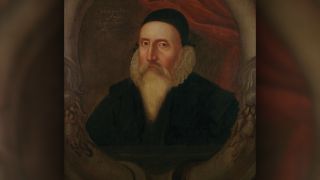 John Dee was a mathematician, astrologer and occultist. (Image credit: Copyright Antiquity Publications Ltd./Ashmolean Museum, University of Oxford)
John Dee was a mathematician, astrologer and occultist. (Image credit: Copyright Antiquity Publications Ltd./Ashmolean Museum, University of Oxford)The 16th-century courtier John Dee, a scientific adviser to England's Queen Elizabeth I, was also deeply involved in magic and the occult, and he tried to commune with ghosts, using a so-called spirit mirror made of polished obsidian.
Now, a new analysis of Dee's infamous mirror has finally traced its origins — not to the spirit world, but to the Aztec Empire.
Obsidian mirrors such as Dee's were known from Aztec culture, but there were no records on his mirror's origins. However, geochemical analysis enabled researchers to link the mirror's obsidian — a type of volcanic glass — to Pachuca, Mexico, a popular source of obsidian for Aztec people. This finding indicated that the artifact was Aztec and not a copy made from European obsidian, and Dee likely acquired the mirror after it was brought to Europe from Mexico, according to a new study.
Though Dee was a scientist and mathematician, his interests also swung toward the magical and mystical, and in addition to the spirit mirror, he owned other objects related to astrology, divination, alchemy and the exploration of "demonic magic," scientists reported Oct. 7 in the journal Antiquity.
Dee claimed that one of these objects, a purple crystal on a chain, was given to him by the archangel Uriel, along with instructions for making a philosopher's stone — the mythical alchemical marvel that promised the gift of eternal life and the ability to turn base metals into gold, according to the Royal College of Physicians (RCP) in London. Dee also possessed a Claude glass, a black glass mirror kept in a sharkskin case, which he used for "peering into the future," according to the RCP.
Dee's obsidian mirror, now in the collection of the British Museum in London, is polished on both sides and is nearly perfectly circular, measuring about 7.2 inches (18.5 centimeters) in diameter and 0.5 inches (13 mm) thick, and weighing about 31 ounces (882 grams). A perforated square tab at the top of the mirror measures about 1.3 inches (33 mm) long and may have served as a handle, according to the study. READ MORE...
